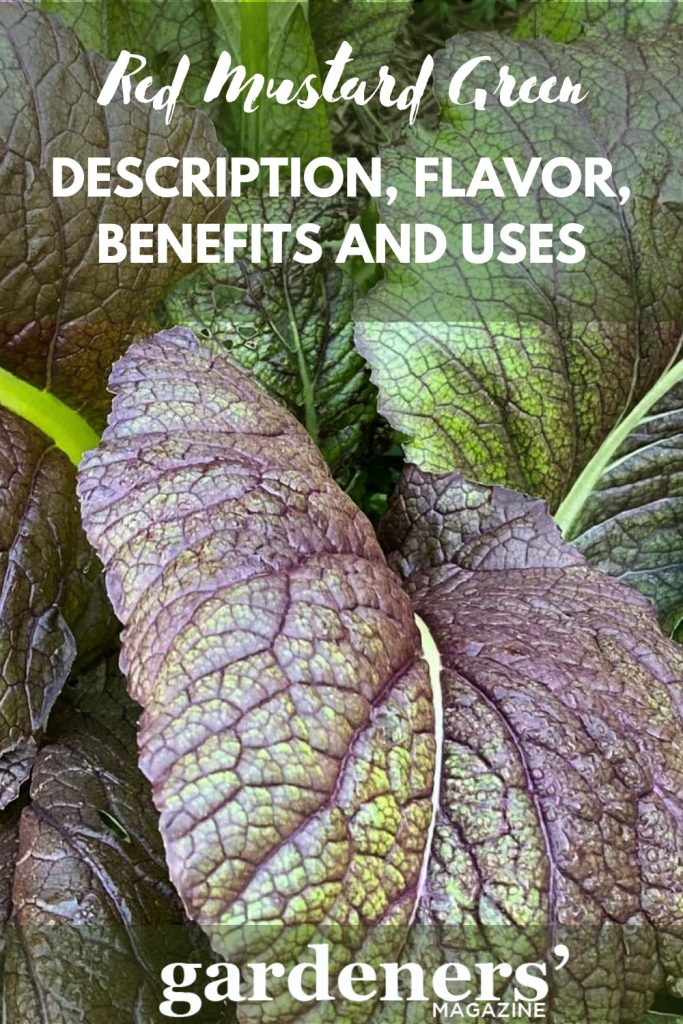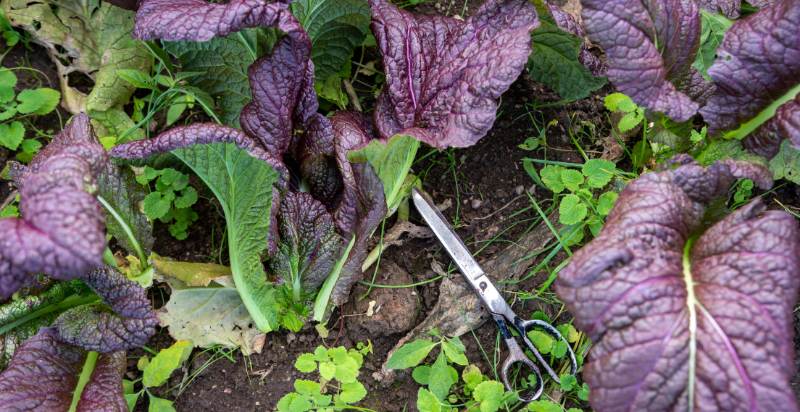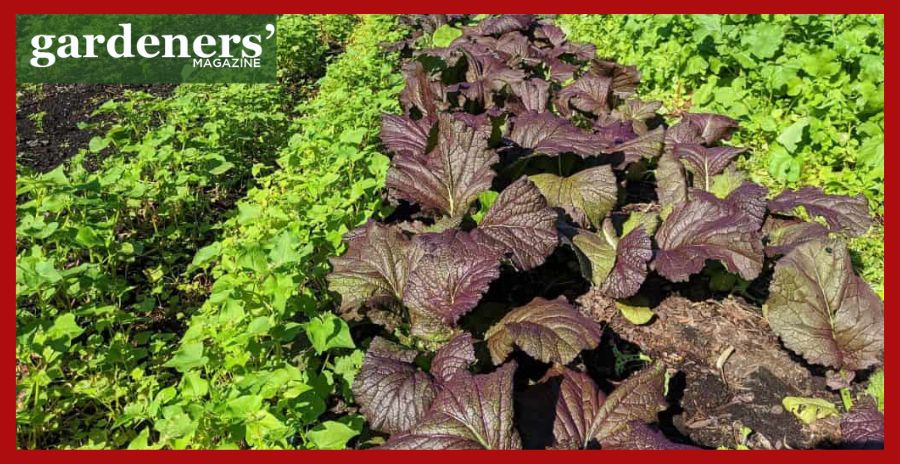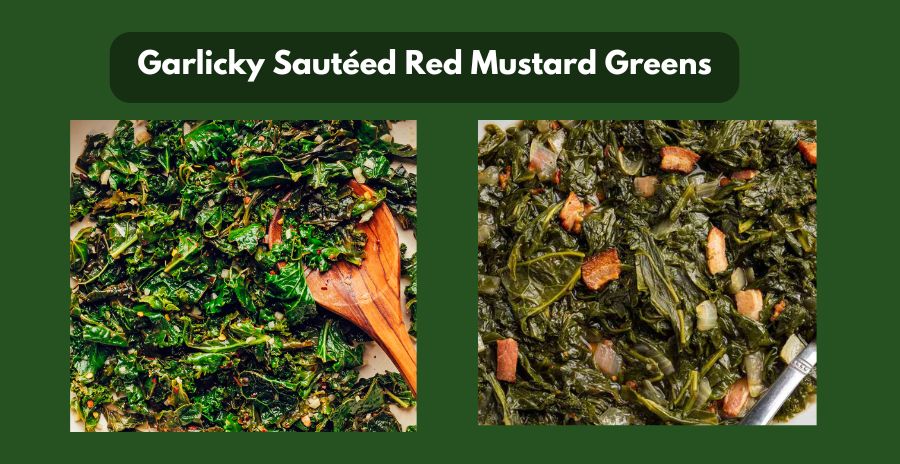I’m delighted to introduce you to the vibrant world of Red Mustard Greens, a leafy vegetable that brings both color and flavor to your garden and kitchen. Belonging to the Brassica family, which includes broccoli, cabbage, and kale, these are known for their striking deep red veins and lush green leaves. Originating from the Himalayan region of India, they have been a staple in Asian cuisines for centuries and are now gaining popularity worldwide for their culinary versatility and health benefits.
Growing Red Mustard Greens is a rewarding experience for any gardener. They thrive in cooler climates and can be planted in both spring and fall. These greens prefer well-drained, fertile soil and benefit from regular watering. What makes them particularly appealing is their resilience and fast-growing nature, making them a great choice for both experienced and novice gardeners.
What are Red Mustard Greens?
Scientifically known as Brassica juncea, these are a type of leafy vegetable belonging to the Brassica family, which includes other members like cabbage, kale, and broccoli. These greens are characterized by their vibrant, deep red or purple veins and lush green leaves, making them not only nutritious but also an aesthetically pleasing addition to any dish. The leaves are tender when young but become tougher as they mature. They can be eaten raw or cooked into soups, stir-fries, sautés, salads, and more. The nutrient-rich leaves are an excellent source of vitamins A, C, calcium, and iron.
Red Mustard Greens also contain dietary fiber and antioxidants, which can help reduce the risk of certain diseases. Red Mustard Greens are a versatile and flavorful ingredient that can enhance any dish. They are easy to find and can be prepared in various ways, making them an ideal addition to any meal.

History and Origin of Red Mustard Greens
Red mustard greens are a variety of Brassica juncea, an Asian species of the Brassicaceae family. The plant has been used for centuries in East Asia as a vegetable and spice. The cultivation of mustard plants is believed to have originated in the Himalayan region of India. These plants have been grown and used for thousands of years, not only as a food source but also for their medicinal properties. From their origin in the Himalayas, mustard greens spread throughout Asia. They have been a staple in many Asian cuisines, particularly in Chinese, Indian, and Japanese cooking, where they are valued for their unique flavor and nutritional benefits. In China, it is known as “hong fueling” (紅芥菜) or simply “hongjie” (紅芥).
They were introduced to Europe in the Middle Ages. They were initially used more for their medicinal qualities than as a culinary ingredient. The greens were brought to the Americas by European settlers, where they became integrated into local cuisines. In the southern United States, for example, mustard greens became a staple in soul food cooking.
Today, red mustard greens are a popular ingredient in Asian cuisine for mustard sauces and condiments. The leaves can be cooked or eaten fresh, and the seeds can be ground and used as a spice. It is also gaining popularity in health food circles due to its high vitamin C, calcium, and iron content. Red mustard greens can be found in some grocery stores and Asian markets.
Description of Red Mustard Greens
Red Mustard Greens, or Brassica juncea, are visually striking vegetables with a unique morphology. They feature large, broad leaves that are deeply veined, exhibiting a rich contrast of deep green and vibrant red or purple hues. The leaves are slightly wrinkled and have a ruffled appearance with jagged or toothed edges. They grow from slender, firm stems that may also show red or purple coloring. Typically, these plants reach a height of 30 to 60 centimeters. The texture of the leaves is crisp and tender when young, becoming more robust as they mature. This vivid coloration and texture make Red Mustard Greens both visually appealing and flavorful.
Flavor Profile of Red Mustard Greens
Red Mustard Greens are known for their distinctive and bold flavor profile. They possess a characteristic peppery taste, which is a hallmark of the Brassica family. The flavor is often described as a mix of spicy and slightly bitter notes, akin to a milder version of horseradish or wasabi. When the greens are young, their taste is more subdued and tender, making them suitable for raw consumption in salads. As the leaves mature, their flavor intensifies, becoming more pungent and robust. This makes them ideal for cooking, as the heat mellows their sharpness, transforming them into a more palatable and slightly sweet taste with complex undertones.
Red Mustard Greens have an unmistakable pungent aroma. When cooked, the flavor of this vegetable mellows out and takes on more of a sweet and salty taste. Red Mustard Greens are a popular ingredient in Asian cuisines but can also be used in Western dishes.

Seasonality and Availability Throughout the Year of Red Mustard Greens
Red Mustard Greens are available throughout the year. However, their seasonality can vary depending on where they’re grown. In warmer climates, such as California and Arizona in the United States, Red Mustard Greens tend to have a longer harvest season and can be found from spring through late fall.
Red Mustard Greens are typically available in late summer and early fall in colder climates, such as those found in Canada or northern regions of the United States. Additionally, they can often be found year-round in milder climates or from commercial sources.
Health Benefits of Red Mustard Greens
Red Mustard Greens are a nutritional powerhouse, offering a plethora of health benefits. They are rich in vitamins A, C, and K, which are crucial for maintaining good vision, immune function, and bone health. These greens are also high in antioxidants and phytonutrients, which help combat oxidative stress and may reduce the risk of chronic diseases like cancer.
The presence of dietary fiber aids in digestion and supports heart health by helping to regulate cholesterol levels. Additionally, Red Mustard Greens contain essential minerals such as calcium and iron, which are vital for maintaining healthy bones and preventing anemia. Their low calories and high nutrient content make them an excellent choice for a healthy diet.
Cultivation of the Red Mustard Greens
These are cool-season crops, thriving in spring and fall. They can tolerate light frosts, making them suitable for early spring and late fall planting in many regions. These greens prefer well-drained, fertile soil with a pH between 6.0 and 7.0. They are adaptable to various soil types but perform best in nutrient-rich soil. Sow seeds directly into the garden, about 1/4 inch deep. Space the seeds or seedlings about 6 inches apart to allow ample room for growth. In warmer climates, they can be grown throughout the winter.
Regular watering is essential, especially during dry spells. The soil should be kept consistently moist but not waterlogged. They need full sun or partial shade. They require at least 3-4 hours of sunlight daily, but too much heat can cause them to bolt (flower and go to seed), especially in warmer months. Once the seedlings have established, mulch around the plants to help keep moisture in the soil.
Prune back any dead or wilting leaves as needed. Red Mustard Greens can be harvested as soon as the leaves are large enough, typically 45-60 days after planting. Harvest by cutting the leaves from the base of the plant or by pulling up the entire plant.

Where do Red Mustard Greens Grow?
These are grown in many regions worldwide but are most commonly found in East Asia, Southeast Asia, South Asia, and Africa. They are commonly grown in East Asia in China, Japan, Korea, Taiwan, and other countries. They are grown in Thailand, Vietnam, Indonesia, and other countries in Southeast Asia. In South Asia, they are popular in India, Pakistan, and Bangladesh. They are grown in Ethiopia, Kenya, Madagascar, and other African countries.
Due to their popularity worldwide, they have been cultivated in Australia, Europe, and North America. In the United States, they are mainly grown in California, Kentucky, New York, and Virginia. However, Red Mustard Greens are not native to the United States, and most imported products come from China.
What are the Things to Remember When Buying Red Mustard Greens?
When buying Red Mustard Greens, consider these important factors:
- First, choose fresh, organic greens. Organic varieties are free from chemical fertilizers and pesticides. Look for leaves that are brightly green and crisp, avoiding any with yellow spots, which suggest they are past their prime.
- Next, give the leaves a sniff; they should emit a slightly sweet and sharp aroma.
- Purchase in small quantities, as these greens wilt quickly. If buying in bulk, keep them fresh by storing them in an airtight container or wrapped in a damp cloth in the refrigerator.
- Before cooking or consuming, wash the leaves thoroughly to remove any dirt or debris.
What is the Best Way to Store Red Mustard Greens?
To properly store them, it’s ideal to place them in a cool and dark environment with good air flow, where the temperature is maintained between 45 and 50°F (7-10°C). If such a space isn’t available, the refrigerator is the next best option. Before storing, ensure the greens are washed and dried.
Place the greens in either a plastic bag or a container, adding a moist paper towel to prevent moisture loss. If using an airtight container, ensure there’s enough space for air movement. For longer storage, freezing the greens is effective; they can be kept frozen for up to three months.
How can Red Mustard Greens be Used in Recipes With Other Fruits and Vegetables?
They can be used in various recipes, from stir fries and soups to salads and side dishes. Add some diced onions to the mix for added flavor when using Red Mustard Greens with other fruits and vegetables. Combine Red Mustard Greens with bok choy, carrots, mushrooms, garlic, ginger, and sesame oil for a delicious Asian-inspired dish. This combination can be cooked in a wok or stir-fry pan for an easy and flavorful meal.
Try sautéing Red Mustard Greens with tomatoes, garlic, onion, and olives for a more Mediterranean flavor. Serve over grilled fish or chicken for the perfect weeknight dinner. Finally, you can combine Red Mustard Greens with apples, pears, and walnuts for a sweet and savory salad. Add some feta cheese and a light vinaigrette to complete the dish. Red Mustard Greens are sure to be a welcome addition to any meal.

Conclusion
Red Mustard Greens are not only a flavorful and nutritious addition to a variety of dishes but also relatively easy to handle in terms of storage and preservation. For optimal storage, washing and drying the greens before putting them in a plastic bag or airtight container with a damp paper towel is best. Red Mustard Greens can be used in stir-fries, soups, salads, and side dishes for a delicious Asian or Mediterranean flavor. With all these options, you’ll surely find the perfect way to incorporate Red Mustard Greens into your weekly meal plan.
- Dino Melons: Description, Flavor, Benefits, And Uses - April 29, 2025
- Pear Trees: Planting, Growing, and Harvesting Pears - March 27, 2024
- Runner Beans (Scarlet Runner Bean): Description, Flavor, Benefits, And Uses - March 21, 2024

8 thoughts on “Red Mustard Greens: Description, Flavor, Benefits, And Uses”
Comments are closed.